1983 French Grand Prix race report
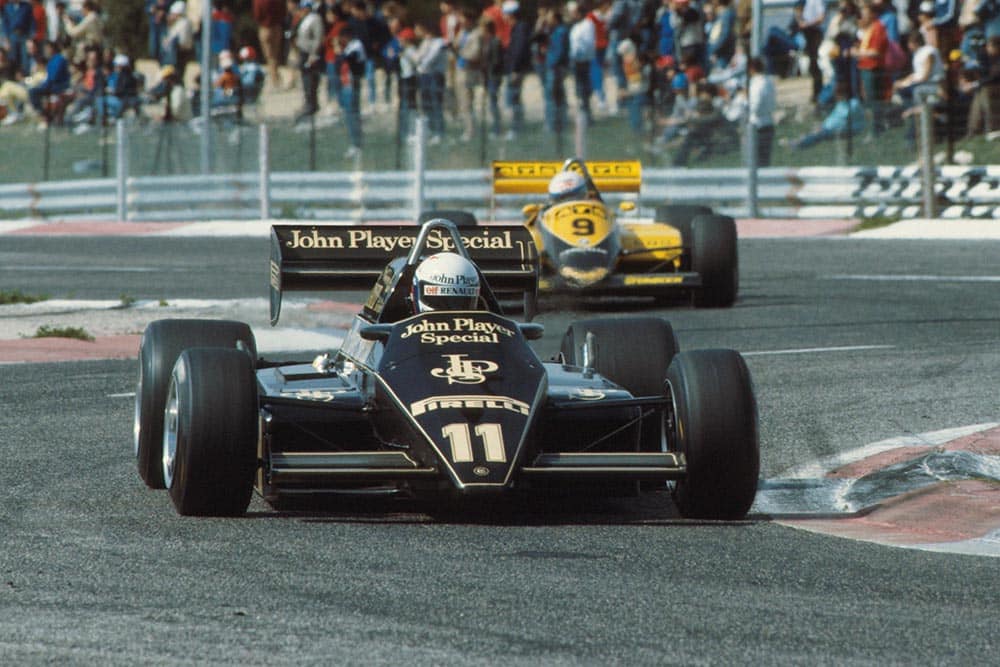
The Lotus of Elio de Angelis leads ATS's Manfred Winkelhock
Motorsport Images
A complete French victory
Le Castellet, April 17th
In a vain attempt to make the French Grand Prix pay at the Paul Ricard circuit on the desert-like plateau in the hills behind Toulon and Bandol, the organisers opted for a date in April instead of their usual July date at the height of the holiday season. It was a misguided move as few people in France or other European countries are interested in making a long journey to the featureless Paul Ricard circuit to spend the day on the dusty plateau to watch not very much.
There was nothing wrong with the entry for it was very full, with 29 drivers and 42 cars filling the pit-lane garages and with all the major teams having spent a lot of time at the circuit during the winter, everyone seemed ready to go. There were two changes to the scene, one being the addition of a second March-RAM driven by Jean-Louis Schlesser who had made his Formula One debut at the Race of Champions and the other the absence of Alan Jones from the Arrows team.
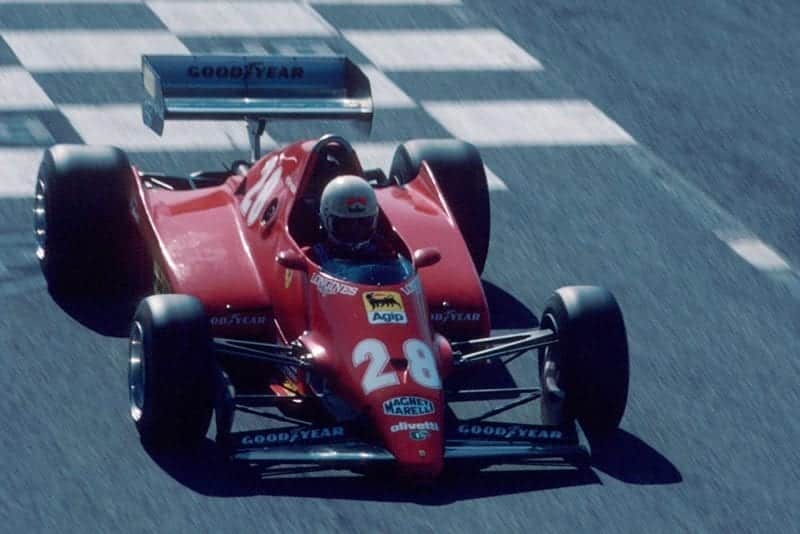
Rene Arnoux secured 4th on the grid for Ferrari
Motorsport Images
Jonesey had agreed to drive the Arrows at Long Beach and Brands Hatch, acting as a “sprat to catch a mackerel”, the mackerel being represented by a big, wealthy sponsor who would pour vast sums of money into the Arrows team purely on the knowledge that Alan Jones would be driving for them. With the team’s known record it was not surprising that no sponsor came forward, even allowing for the known qualities of Alan Jones; and that was that, Jones stepped out of his commitment and the Arrows cars were unsponsored apart from some small local advertising. It would look as though the sea has dried up as far as mackerel are concerned, leaving only a few basking sharks! Just in case anyone in a half-decent car should fall ill, or have an accident, Alan Jones was in the pits with his driving equipment not far away.
On the car front Renault were looking strong with new RE40 cars for Prost (RE40/01) and Cheever (RE40/02) and the 00 prototype as stand-by and Lotus were looking equally strong with two Renault-powered cars for de Angelis and two Cosworth-powered cars for Mansell. The Lotus 93T/1 had the latest RE40 engine installation and the Lotus 92 cars were running with normal suspension in place of the computer-controlled hydraulic suspension as its advantage seems to have disappeared and its weight disadvantage being too much of a handicap.
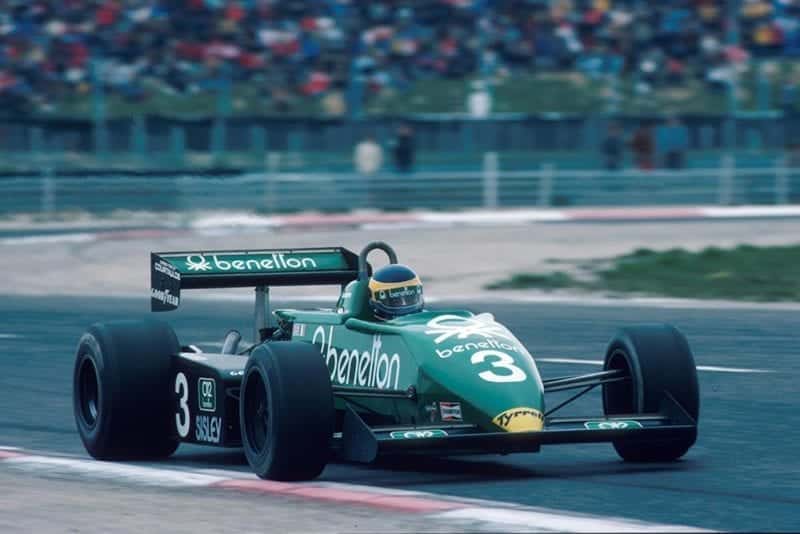
Michele Alboreto in his Tyrrell 011.
Motorsport Images
Mansell had one of the new Cosworth DFY engines available, which he used for the first time during the second day of practice. The Williams team had a DFY engine but did not use it, though they had a brand new car as a spare for Rosberg (FW08C/09). The McLaren team had two new DFY engines, and one was installed in Lauda’s car for the second day of practice and the other in Watson’s car for the final hour. These engines have different bore and stroke to the DFV, the 90 mm. bore allowing larger valves and a better shape of combustion chamber which has filled in some of the deficiencies in the power curve in the middle range without increasing the r.p.m. or making much difference to the peak power output. They have been described as “shortstroke screamers” suggesting that the shorter stroke has allowed more r.p.m. and more power, but in fact they should be called “big bore boomers” to be more exact.
The Toleman team added a third car to their strength and Alfa Romeo had to build a fourth turbo V8 car to replace the one that Baldi crashed at Long Beach. The Brabham team were running carbonfibre disc brakes on all three of their BMW-powered cars, and McLaren also had carbonfibre discs on their MP4/1C cars. Ferrari had converted their three cars to external air-starters in place of their electric starters and had saved a lot of weight elsewhere and Theodore (Ensign) were robbing bits off the old original carbonfibre composite monocoque car to keep their two new ones going. Ferrari, Ligier, Alfa Romeo and Renault had equipped their cars with quick-action refuelling fillers on the right-hand side of their tanks in preparation for refuelling stops like the Brabham team, the Ferrari refuelling equipment looking like a space satellite made in galvanised iron standing ready for launching, while the Renault equipment was small and neat.
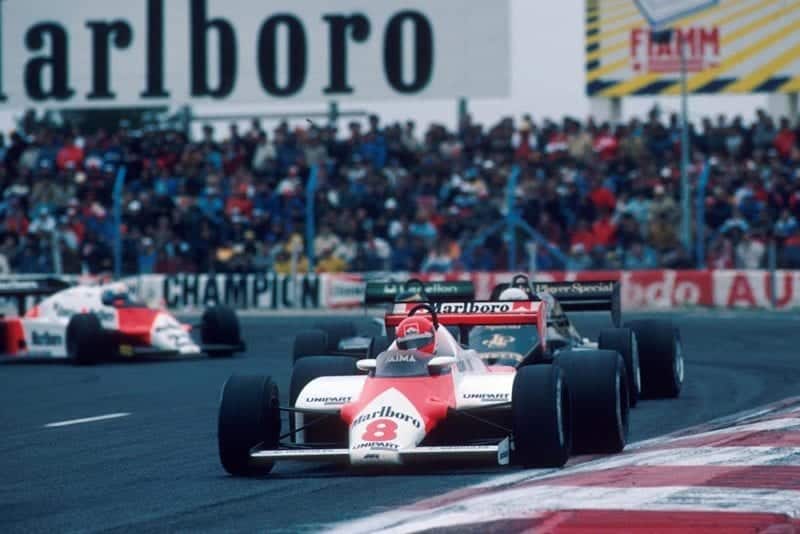
McLaren’s Niki Lauda would qualify 12th
Motorsport Images
With the recently introduced car-weighing procedure during afternoon qualifying the double entry and exit to the fantastically long pit lane at the Paul Ricard circuit could not be used and everyone had to enter by the first entry and leave by the far exit, which caused a few qualms as anyone in a hurry could be doing 130 m.p.h. by the time he reached the end of the pit lane!
Qualifying
Practice and qualifying, held to the normal format of an hour-and-a-half in the morning for testing and an hour in the afternoon for qualifying for the grid, took place on Friday and Saturday in clear, fine but cool weather and was totally dominated by turbo-powered cars, which was not surprising when you appreciate that Brabham, ATS, Lotus, Renault, Alfa Romeo, Ferrari and Toleman-Hart are all using 1½-litre turbo-engines. Those teams stuck with the obsolete Cosworth DFV and the not-so-obsolete Cosworth DFY engines could barely hope to get in the top ten on the grid. Apart from spot-check weight measurements during the two qualifying periods, and of course the limit of only two sets of tyres to each driver, there was some severe scrutineering immediately after qualifying on each day, during which weights were taken, bore and stroke measurements were checked and detail regulations were checked.
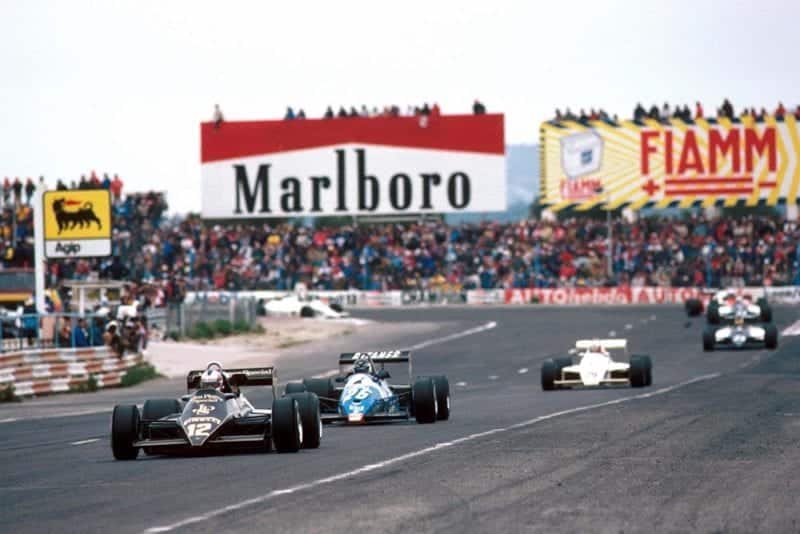
Nigel Mansell’s Lotus leads the Ligier of Jean-Pierre Jarier
Motorsport Images
One of these checks on Friday revealed that the on-board fire-extinguishers on the Alfa Romeo 183T/02 of de Cesaris were empty, so his qualifying time was disallowed, which was unfortunate for the Euroracing Alfa Romeo team as he had made fastest lap of the day. On the second day all three Renault cars had to suffer the indignity of close scrutiny at their own Grand Prix, but all was well, nothing was found amiss.
The Ferrari team had a terrible time during both days of practice, or to be more precise half of the team did, for while Arnoux had a trouble-free time with 126C2/064, Tambay had more trouble than you would imagine possible with 126C2/065 and the T-car 126C2/062. If the engine didn’t go wrong, the electrics of the electronic fuel-injection went on the blink, and when that was put right turbocharger bearings broke up, or the turbines seized. On two occasions Tambay’s car went wrong before it left the pit lane, and on other occasions he had to abandon a car out on the circuit. It stretched his cool debonair demeanour to its fullest extent and nearly drove Forghieri, and his engineers and mechanics up the wall. It never seemed to be the same thing twice so diagnosis was impossible and there seemed to be an inexhaustible supply of new engines coming from the transporter. In comparison the Toleman team had an easy time, but to them it seemed nothing but trouble. On Friday afternoon Warwick had barely started when the fuel pump seized and he had to abandon the car out on the circuit. The spare car was really only a standby in case of a major catastrophe, so Warwick had to wait until Giacomelli had finished and then use his car to record a time.
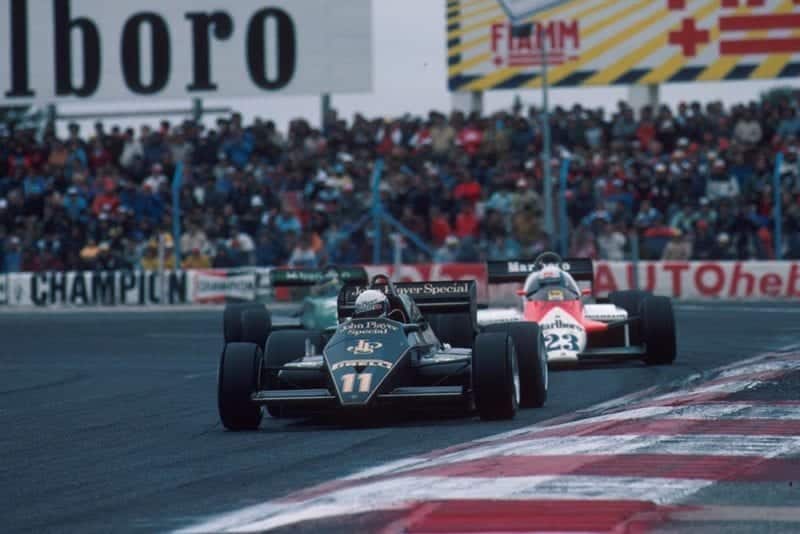
The Lotus of Elio de Angelis leads the Alfa Romeo of Maurro Baldi and the Tyrrell of Michele Alboreto.
Motorsport Images
Tyres were still confusing a lot of people, which is not surprising with as many as six different types to choose from. The Pirelli firm had literally been working round the clock on eight-hour shifts to complete a whole new series of tyres for Lotus, Toleman and March, and Goodyear had flown 1800 tyres over from Akron. The Brabham team seemed unable to generate any serious temperatures in the Michelins on the front of the arrow-like BT52 cars and had to resort to the drastic measure of bolting 11 kilogrammes of lead into the nose to assist the front aerofoil in its job of pressing the front tyres onto the road.
In spite of the practice and qualifying pace being pretty fast and furious and the 1983 regulation cars not being as stable as the 1982 cars there were surprisingly few excursions off into the rough or the catch-fences, the only spectacular one being that of Serra on Saturday afternoon when a rear tyre failed on his Arrows at high speed through the esses after the pits. The car was badly damaged, but the driver got away unharmed and once the catch fences had been rebuilt he continued his qualifying in the spare car.
During the two days of practice the weather had been comfortably warm, or cool, depending on what you were used to, and the Mistral wind had kept away, appearing as nothing more serious than a gentle, friendly breeze, while the sun shone most of the time. On Sunday the whole area was grey and overcast, but thankfully it kept dry and an estimated 30,000 spectators paid to watch the event while Chinese, Mongolians, Indians, Peruvians and Zimbabwians gathered round their television sets to watch, if we are to believe the TV moguls.
Race
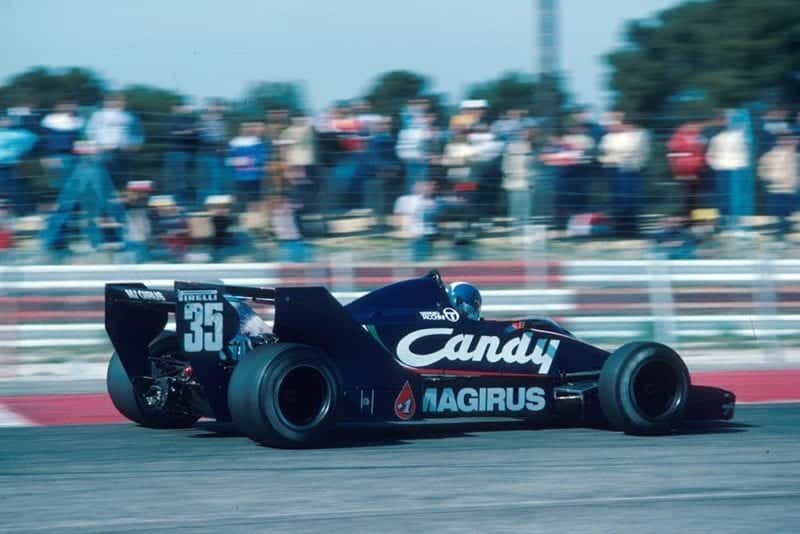
Derek Warwick put his Toleman an impressive 9th on the starting grid
Motorsport Images
The regulation Sunday morning warm-up half-hour was not without its excitement as various teams practised rapid wheel changes, managing 15 seconds from stop to start with all four wheels. Ferrari were still in trouble with their KKK turbochargers, this time on Arnoux’s car, and Tambay had elected to race the T-car. In the Brabham team BT52/2 had some trouble with its monocoque and rather than make a hurried repair Gordon Murray installed Patrese in the T-car, and Piquet was doing some last-minute fuel consumption checks. Both McLarens were planning to race with their DFY engines, as was Mansell with the Lotus 92 and the pit layout had reverted to the double entry and exit with the Ligier team being moved beyond the central exit hump as their long cars would have grounded. The RAM-March team had packed up as neither of the drivers qualified, but Osella were looking happier with one of their cars destined for the starting grid. The trick started last year by the Brabham team of running the race in two halves with a pit-stop in between, to take advantage of running light with half a tank of petrol and using 100 mile life tyres, was being copied by Ferrari, Renault and Williams but Alfa Romeo decided to opt out of the pit-stop race. The object was to take advantage of the lighter weight and stickier short-life tyres, to pull out sufficient lead in the first half to allow for the pit-stop and then to run hard again through the second half, this strategy estimated to be better than running non-stop at a lower speed. It certainly presented an interesting situation with Ferrari, Williams, Brabham and Renault all in neighbouring pits and the feeling of the other teams at the opposite end of the pit lane was that it was a good idea to put them all together, though Ken Tyrrell thought differently as his pit was in the middle of all the refuelling teams!
In true French style the race was not due to start until well after lunch time and before the cars left the pit lane disaster struck the Lotus team when their mechanics inadvertently ran a car over Nigel Mansell’s left foot and crushed his toes. In spite of being in severe pain the plucky Midlander agreed to start the race and keep going for as long as he could.
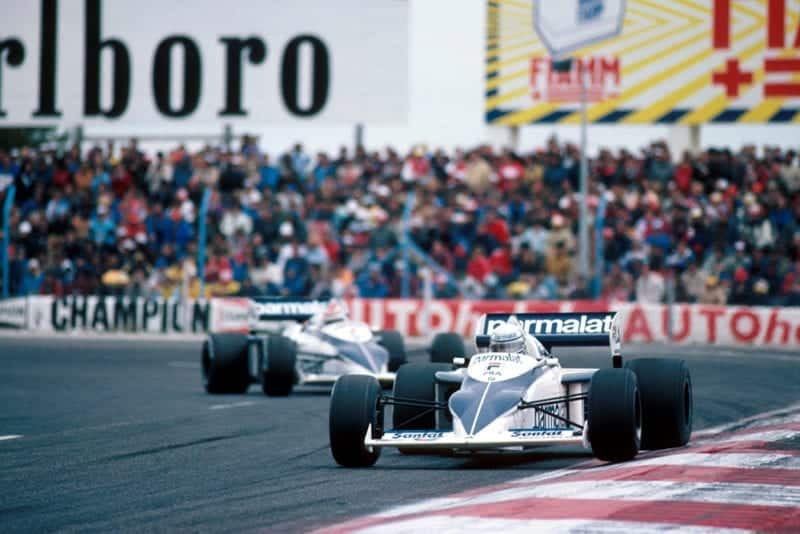
Riccardo Patrese leads his Brabham team mate Nelson Piquet
Motorsport Images
All 26 cars were ready to go and most of the spectators seemed to be wandering about freely on the inside of the circuit, while in excellent Indianapolis style the whole pit area had been closed to everyone except team members engaged on a specific job, and at one end of the pit lane that job was refuelling and wheel changing about half way through the 54 lap race. With turbocharged cars in the first 11 places on the grid those doubters who still think there is a future in the unsupercharged 3-litre engine and who could see no future in forced induction racing engines, didn’t have much to be hopeful about. There were in fact two distinct races to be run, one for the factory teams and one for the private teams, with those like Williams and McLaren just able to bridge the gap. From the word go Alain Prost in the pole position Renault RE40 drove away as he wished, building up a commanding lead while his new team mate Cheever hung on to second place as best he could but he was harassed by the BMW powered Brabhams of Piquet and Patrese, with the two Ferraris of Tambay and Arnoux following.
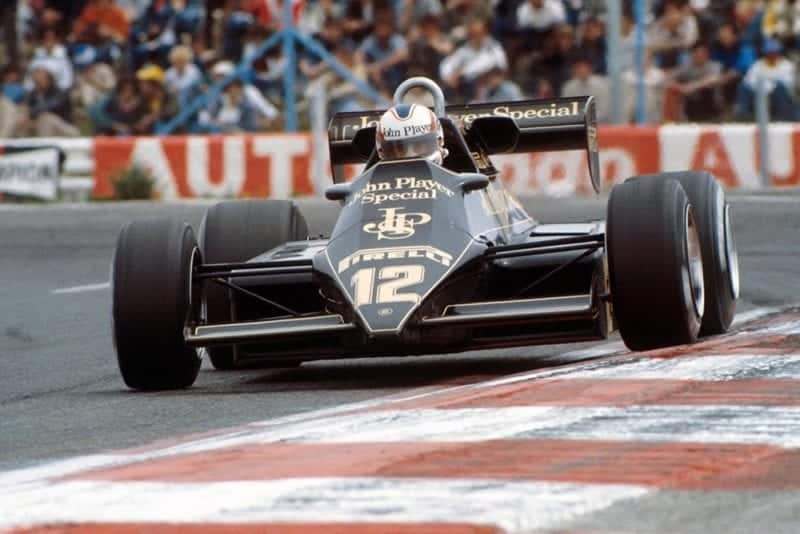
Nigel Mansell had to retire on lap 18 after an injury meant he could go on no futher
Motorsport Images
Driving as hard as he knew how Rosberg was not only hanging on to the second Ferrari but was actually challenging it, after having passed the Lotus-Renault of de Angelis. Apart from the lone Williams with Cosworth power it was turbocharged cars all the way for Winkelhock in the ATS-BMW and de Cesaris in the first of the turbocharged Alfa Romeos were leading the rest of the field.
On the opening lap there had been trouble at the back of the field for Watson had crumpled the nose of his McLaren on the back of Baldi’s turbo-charged V8 Alfa Romeo and both cars had gone into the pits, the McLaren for a new nose-cone and the Alfa Romeo for a new pair of rear tyres. On lap 4 Watson’s new Cosworth DFY, which had been installed the previous afternoon, blew up and then Mansell was forced to give up as his foot injury was giving him too much pain. The two Renaults dominated the scene until lap 18, when Piquet forced his Brabham by Cheever into second place, but a long way behind the flying Prost. In fourth place was Patrese in the second Brabham, then came Tambay a fair way back followed at an even greater distance by Rosberg and Arnoux and Laffite in the second Williams, de Cesaris, Winkelhock, de Angelis, Lauda, Alboreto and the rest. Warwick had collected a puncture in his left-rear Pirelli and after a stop to change tyres he only went a couple more laps before his Hart engine broke. Next to go was Patrese, whose BMW engine began overheating due to a serious loss of water and by lap 20 it was all over, with Prost out on his own, Piquet second followed by Cheever, then Tambay a long way behind followed by Rosberg, Arnoux and Laffite, but the interest lay in the fact that all seven of them were due to make a pit stop for new tyres and a half tank of petrol.
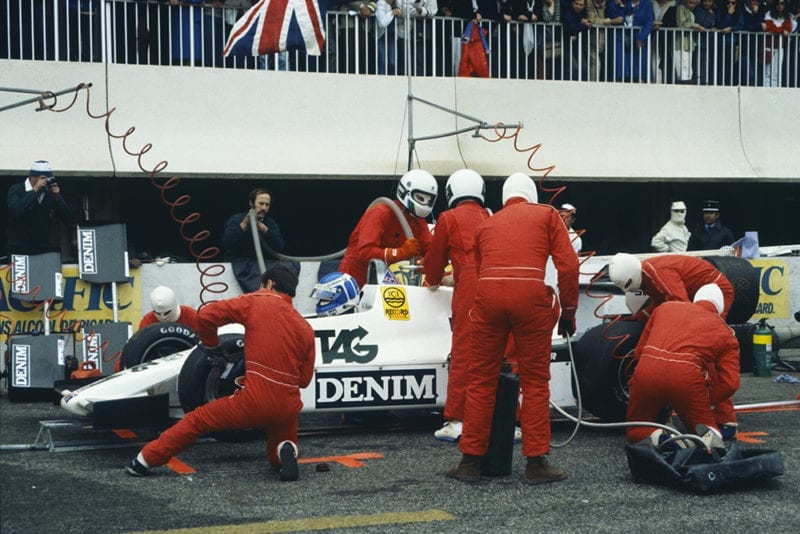
Keke Rosberg comes into the Williams pit on his way to 5th
Motorsport Images
Between lap 25 and lap 34, in other words either side of half distance, all seven made pit stops and when it was all over the, race order was exactly the same, which suggested that the whole pit-stop routine was really rather a waste of time as it gave no-one an advantage. Each of the seven had chanced the possibility of their team making a nonsense, but such is the professionalism of the leading teams in Formula One that nobody made any serious mistakes so the outcome of the race was completely unchanged by the pit stop routine. Arnoux was the first to come in, and apart from nearly running over the Renault mechanics who were waiting for Cheever, the Ferrari was refuelled and new wheels and tyres fitted in 15.71 sec. Cheever’s stop for similar treatment by the Renault team took 17.59 sec. and then Rosberg sped into the pits for tyres and fuel, but the left front wheel baulked slightly on being fitted and the Williams was stationary for 26.15 sec. Then Prost appeared in the pit lane and while he was there Piquet went by into the lead, but it was to be a short-lived lead as he was due to stop. The Renault was stationary for 24.18 sec. due to Prost stalling the engine and letting his foot off the brake pedal before the right rear wheel was tightened, all of which wasted precious seconds. Then Tambay was in and away with new tyres and half a tank of petrol in 15.66sec., the Ferrari team once again proving that the days of comic opera at a pit stop by the Maranello team are long gone. Piquet relinquished the lead of the race back to Prost when the Brabham stopped for 16.07 sec. for new tyres and petrol and the last one to come in was Laffite. Before he arrived the Goodyear people had inspected the tyres of Rosberg’s car and decided that Laffite could go right through to the finish on his original tyres, so he was merely refuelled in a very swift 13.78 sec. He rejoined the race just ahead of Rosberg, but the reigning World Champion did not intend to run as the second Williams and soon sliced his way ahead.
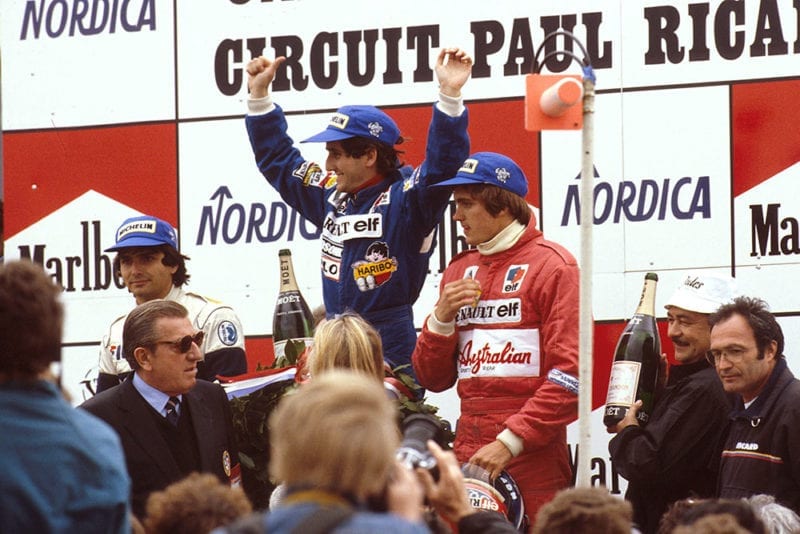
Alain Prost, 1st position, Nelson Piquet 2nd position and Eddie Cheever, 3rd position on the podium.
Motorsport Images
After all that excitement in the pits that only a handful of spectators actually witnessed, the outcome of the race was unchanged suggesting that it really was a waste of time and effort, but it had been interesting. With the order being Prost (Renault) Piquet (Brabham-BMW), Cheever (Renault), Tambay (Ferrari), Rosberg (Williams), Laffite (Williams) and Arnoux (Ferrari) it was just a matter of everyone keeping station for the second half of the race. Of the seven drivers that stopped, Arnoux had lost the most ground and was actually down to eleventh place before he got back into his stride and pulled back up to seventh place ahead of Alboreto’s Tyrrell which was running through non-stop.
The only happenings were those that caused retirements, such as the contact between Winkelhock’s ATS and Baldi’s Alfa Romeo which put the Italian car on to the loose gravel on the left of the pits straight from which it spun right across the track and into the guard-rail on the right of the track, wrecking its right-rear corner. Lauda dropped out with something seized at the rear of his McLaren, and Winkelhock went out with broken suspension. Giacomelli retired the second Toleman with transmission failure and de Cesaris lost a lot of time at the pits with a deranged gearlever linkage. Sullivan’s Tyrrell blew up its engine in a pretty spectacular manner and Guerrero’s Theodore and Boesel’s Ligier went out with engine trouble.
After losing last year’s French Grand Prix to his trouble-making teammate, Prost made no mistakes this year and won at a rousing 199.866 k.p.h., only a fraction slower than Arnoux’s winning speed last year, and taking only 40 seconds longer to run the same distance, including a stop this year. The turbo-charged V6 Renault driven by the little Frenchman on Michelin tyres and using ELF petrol and oil made it a total French victory to the relief of all concerned for the lack of results recently by the Renault-ELF team has been proving extremely embarrassing for everyone. — D.S.J.
